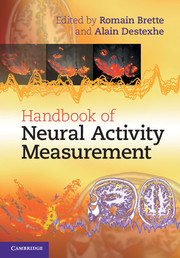Book contents
- Frontmatter
- Contents
- List of contributors
- 1 Introduction
- 2 Electrodes
- 3 Intracellular recording
- 4 Extracellular spikes and CSD
- 5 Local field potentials
- 6 EEG and MEG: forward modeling
- 7 MEG and EEG: source estimation
- 8 Intrinsic signal optical imaging
- 9 Voltage-sensitive dye imaging
- 10 Calcium imaging
- 11 Functional magnetic resonance imaging
- 12 Perspectives
- Plate section
- References
10 - Calcium imaging
Published online by Cambridge University Press: 05 October 2012
- Frontmatter
- Contents
- List of contributors
- 1 Introduction
- 2 Electrodes
- 3 Intracellular recording
- 4 Extracellular spikes and CSD
- 5 Local field potentials
- 6 EEG and MEG: forward modeling
- 7 MEG and EEG: source estimation
- 8 Intrinsic signal optical imaging
- 9 Voltage-sensitive dye imaging
- 10 Calcium imaging
- 11 Functional magnetic resonance imaging
- 12 Perspectives
- Plate section
- References
Summary
Over the past 30 years calcium-sensitive fluorescent dyes have emerged as powerful tools for optical imaging of cell function. Calcium ions subserve a variety of essential functions in all cell types. For example, changes in intracellular free calcium concentration ([Ca2+]i) underlie fundamental cellular processes such as muscle contraction, cell division, exocytosis, and synaptic plasticity. Most of these processes rely on the steep gradient of calcium ion concentration that is actively maintained across the plasma membrane. Moreover, cells store calcium ions in intracellular organelles, enabling them to release a surge of Ca2+ into the cytosol where and when needed. Calcium ions act through molecular binding to various Ca2+-binding proteins, inducing conformational changes and thereby activating or modulating protein function. The development of optical reporters of calcium concentration has opened great opportunities to read out [Ca2+]i directly as a crucial intracellular messenger signal. A major application of calcium indicators is the quantitative study of a specific calcium-dependent process X, for example, neurotransmitter release, with the goal to reveal the function X = X([Ca2+]i). However, this is not the only type of application. Because neuronal excitation in the form of receptor activation or generation of action potentials typically is linked to calcium influx, calcium indicators are also used to reveal neural activation patterns, either within the dendritic tree of individual cells or within cell populations.
- Type
- Chapter
- Information
- Handbook of Neural Activity Measurement , pp. 362 - 409Publisher: Cambridge University PressPrint publication year: 2012
References
- 2
- Cited by



